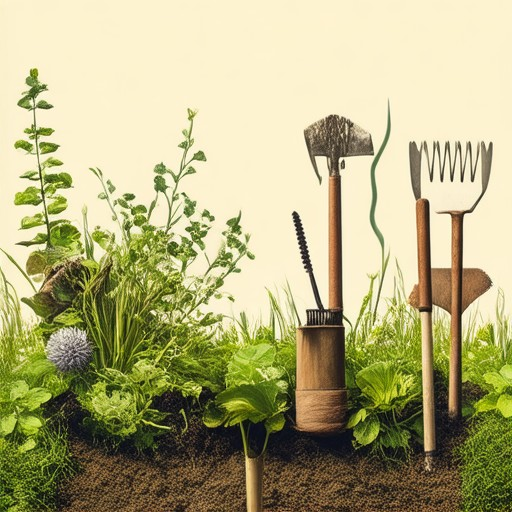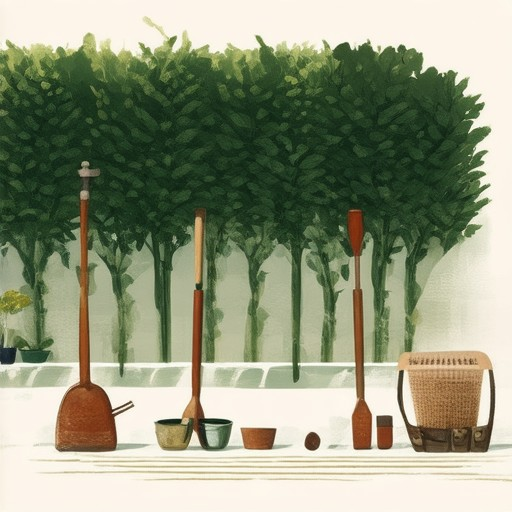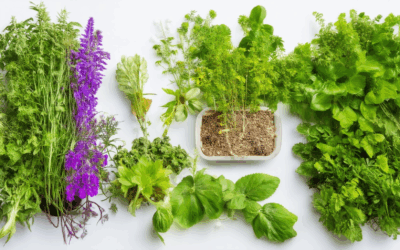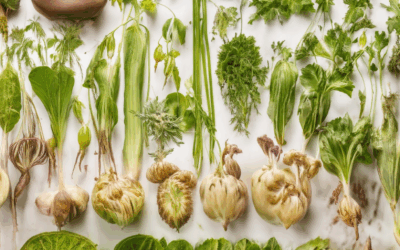Gardening has been a cornerstone of human civilization for millennia, with traditional tools serving as testament to the ingenuity and resourcefulness of early societies. These classically designed implements, often passed down through generations, continue to hold a special place in the hearts of gardeners worldwide. While modern technology may offer sleek, efficient alternatives, there’s something undeniably charming about the simplicity and functionality of traditional gardening tools. From the humble shovel to the iconic watering can, these tools represent not just utility but also a connection to our collective past. In this article, we’ll delve into the world of traditional gardening tools, exploring their history, uses, and even comparing them to their contemporary counterparts. Whether you’re a seasoned gardener or simply curious about the origins of these timeless pieces, this exploration will shed light on why traditional tools remain a beloved choice for many. We’ll also take a closer look at some of the most iconic names, complete with pictures to bring their stories to life. So, let’s embark on a journey through the ages and uncover the enduring allure of traditional gardening tools.
Key Takeaways
– Trowel: Used for planting small seeds or bulbs and digging shallow holes.
– Spade: Ideal for digging larger areas like flower beds or vegetable gardens.
– Shovel: Necessary for deeper digging tasks, such as trenching or removing large amounts of soil.
– Wheelbarrow: Essential for transporting soil, plants, or tools around the garden.
– Bush Cutter: Used to trim shrubs and bushes, keeping them shaped and tidy.
– Lawn Mower: Required for cutting grass, whether manual or electric.
– Hedge Trimmer: Designed to trim hedges and keep edges neat.
– Pruning Shears: Used for pruning trees and shrubs to maintain their shape.
– Hand Tiller: Helps aerate the soil and prepare it for planting.
– Knorker: A versatile tool for digging small holes and planting bulbs.
– Watering Can: Needed for watering plants evenly and deeply.
– Fertilizer Spreader: Used to distribute fertilizer evenly across the garden area.
– Insecticide Sprayer: Applied to protect plants from pests and diseases.
– Garden Hose: Vital for watering plants and cleaning debris from tools.
– Greenhouse Heater: Provides warmth during colder months for seedlings.
– Plant Support Frames: Help plants grow upright, especially tall varieties.
– Potting Soil: Essential for container gardening and plant propagation.
– Seeding Tray: Used for germinating seeds indoors before planting outdoors.
– Garden Gloves: Protects hands while handling soil and plants.
– Protective Eyewear: Recommended for tasks involving dust or debris.
– Garden Apron: Useful for carrying tools and protecting clothing.
When selecting gardening tools, consider the specific tasks you’ll perform. Heavy-duty tools may be better suited for larger gardens, while lightweight options are ideal for smaller spaces or delicate plants. Always choose tools that match your gardening style and needs for optimal efficiency.
Traditional Device for Gardening
The traditional device used for gardening is the hand trowel . This versatile tool is essential for various gardening tasks, including planting, weeding, and harvesting. Its compact design allows for precise work in small spaces, making it a staple in any gardener’s toolkit.
Here are some traditional gardening tools and their uses:
- Hand Trowel : Perfect for digging small holes, planting seeds, and removing weeds. Its ergonomic handle makes it comfortable to use for extended periods.
- Garden Fork : Ideal for loosening soil and aerating the ground. It helps improve soil drainage and promotes healthy plant growth.
- Seedling Tray : Used for germinating seeds before planting them outdoors. This allows gardeners to monitor seed progress closely.
- Pruning Shears : Necessary for trimming overgrown plants and shaping shrubs. Keeping plants pruned encourages healthy growth and prevents damage from branches.
- Watering Can : A simple yet effective tool for watering plants. It allows for targeted watering without wasting water.
These tools highlight the importance of having the right equipment for successful gardening. By using traditional devices like the hand trowel and garden fork, gardeners can maintain their plots effectively and enjoy the fruits of their labor.
What Are Basic Gardening Tools?
When starting your gardening journey, equipping yourself with the right tools is essential for success. Here’s a curated list of fundamental gardening tools that every beginner needs:
- Garden Fork : Perfect for digging and loosening soil, especially useful for larger gardening projects.
- Garden Spade : Ideal for deeper digging tasks, helping you prepare the ground for planting.
- Trowel : A small yet powerful tool for planting seeds and transferring plants, perfect for precise work.
- Hand Shovel : Compact and lightweight, ideal for smaller gardens or moving large amounts of soil.
- Pruning Shears : Essential for trimming overgrown plants and shaping shrubs effectively.
- Bush Cutter : Great for clearing weeds and underbrush, making your garden look neat and tidy.
- Gardening Gloves : Protect your hands while working with dirt and plants, preventing blisters and cuts.
- Watering Can : A reliable tool for giving your plants the consistent moisture they need.
- Plant Markers : Help you keep track of your plants and ensure proper spacing during seeding.
- Wheelbarrow : A versatile tool for transporting soil, plants, and supplies around your garden.
- Garden Hose : Necessary for watering your plants efficiently and keeping your garden hydrated.
- Seeds and Plants : While not a tool per se, having a variety of seeds and young plants ready is crucial for starting your garden.
These tools will help you maintain your garden effectively. For more tips on sustainable gardening practices and heirloom varieties, explore our heirloom gardening section.
The Oldest Gardening Tool
The oldest known gardening tool is the plow , which dates back approximately 5,500 BCE during the Neolithic era. Invented in ancient Mesopotamia, the plow was a revolutionary tool that enabled large-scale farming, supporting the development of settled communities and organized agriculture. This innovation marked a pivotal step in human history, facilitating crop cultivation on a scale that was previously unimaginable.
Flint tools, predecessors to the plow, were used for cutting plants, but they were more suited for tasks like hunting and gathering rather than systematic gardening. The plow, however, was specifically designed for tilling the soil, making it the first tool tailored for intensive gardening practices.
While other tools like the hoe and shovel have existed for millennia, the plow stands out as the most significant early gardening implement due to its impact on agricultural productivity and societal advancement.
Over time, variations of the plow evolved, becoming a cornerstone of farming practices worldwide. Its enduring legacy underscores its importance as one of humanity’s earliest innovations in gardening technology.
What Are the Names of Gardening Tools?
Gardening requires a variety of tools to maintain healthy plants and a well-kept garden. Here’s a list of essential gardening tools along with their primary uses:
- Trowel : Used for planting small seeds or bulbs and digging shallow holes.
- Spade : Ideal for digging larger areas like flower beds or vegetable gardens.
- Shovel : Necessary for deeper digging tasks, such as trenching or removing large amounts of soil.
- Wheelbarrow : Essential for transporting soil, plants, or tools around the garden.
- Bush Cutter : Used to trim shrubs and bushes, keeping them shaped and tidy.
- Lawn Mower : Required for cutting grass, whether manual or electric.
- Hedge Trimmer : Designed to trim hedges and keep edges neat.
- Pruning Shears : Used for pruning trees and shrubs to maintain their shape.
- Hand Tiller : Helps aerate the soil and prepare it for planting.
- Knorker : A versatile tool for digging small holes and planting bulbs.
- Watering Can : Needed for watering plants evenly and deeply.
- Fertilizer Spreader : Used to distribute fertilizer evenly across the garden area.
- Insecticide Sprayer : Applied to protect plants from pests and diseases.
- Garden Hose : Vital for watering plants and cleaning debris from tools.
- Greenhouse Heater : Provides warmth during colder months for seedlings.
- Plant Support Frames : Help plants grow upright, especially tall varieties.
- Potting Soil : Essential for container gardening and plant propagation.
- Seeding Tray : Used for germinating seeds indoors before planting outdoors.
- Garden Gloves : Protects hands while handling soil and plants.
- Protective Eyewear : Recommended for tasks involving dust or debris.
- Garden Apron : Useful for carrying tools and protecting clothing.
When selecting gardening tools, consider the specific tasks you’ll perform. For instance, heavy-duty tools may be better suited for larger gardens, while lightweight options are ideal for smaller spaces or delicate plants. Always choose tools that match your gardening style and needs for optimal efficiency.
Explore our collection of heirloom gardening tools and sustainable practices to enhance your gardening experience. Discover tips for maintaining your tools and extending the growing season with our expert guides.
Dutch Hoe vs Garden Hoe
A Dutch hoe and a garden hoe are both tools used for digging and preparing soil, but they differ significantly in design and functionality. Here’s a breakdown of their key characteristics:
- Purpose and Design :
- Garden Hoe : Typically designed for general-purpose use, the garden hoe is often straight or slightly curved with a flat blade. It’s ideal for turning over small amounts of soil or removing weeds in garden beds.
- Dutch Hoe : The Dutch hoe is a specialized tool, often longer and more robust than the standard garden hoe. Its design includes a curved or semi-curved blade, which allows it to cut through dense soil efficiently. This makes it particularly useful for working in heavy clay or wet conditions prevalent in many parts of the Netherlands.
- Efficiency :
- Garden Hoe : Suitable for lighter tasks and smaller areas, the garden hoe is versatile but may require more effort when dealing with tough soil.
- Dutch Hoe : Designed for efficiency, the Dutch hoe can handle larger areas quickly due to its longer reach and stronger blade. It’s perfect for professional farmers or serious gardeners tackling extensive projects.
- Ergonomics :
- Both tools are ergonomic, but the Dutch hoe often features a comfortable grip and a balanced design that reduces strain during long sessions.
- Regional Adaptation :
- The Dutch hoe has evolved to suit the specific challenges of Dutch agriculture, where heavy clay soils and frequent rainfall make traditional tools less effective.
In summary, while both tools serve similar purposes, the Dutch hoe excels in efficiency and durability, making it a favorite among professionals and serious gardeners.
What is a Matlock Used For?
A Matlock is a type of shear machine primarily used in the metal fabrication and construction industries. Its main purpose is to cut thick metal sheets, such as steel, stainless steel, and aluminum, into smaller pieces or shapes. This process is essential for creating structural components, plates, and other materials required for building machinery, vehicles, and infrastructure.
Key Functions of a Matlock:
- Cutting Thick Metal Sheets : The Matlock operates by loading a metal sheet onto its bed and then using a saw blade to cut through the material. It can handle various thicknesses and sizes, making it suitable for diverse industrial applications.
- Precision Cutting : The machine is known for its precision, allowing operators to make accurate cuts according to specified dimensions. This level of accuracy is critical for producing consistent and reliable metal parts.
- Efficiency in Production : Matlocks are often used in high-volume production environments due to their ability to quickly process large metal sheets, reducing downtime and increasing productivity.
- Versatility Across Industries : The Matlock finds applications in industries such as automotive manufacturing, construction, shipbuilding, and more, where heavy-duty metal processing is required.
Applications:
- Manufacturing Machinery : Components for machines and equipment often require precise metal parts that can only be produced using a Matlock.
- Construction and Infrastructure : Large-scale projects rely on beams, plates, and other structural elements that are cut using this machine.
- Shipbuilding : Thick metal sheets are commonly used to construct hulls and other parts of ships, necessitating the use of a Matlock.
Maintenance and Safety:
- Regular Maintenance : To ensure optimal performance, operators must perform routine checks and follow maintenance schedules to prevent breakdowns.
- Safety Protocols : Given the potential hazards associated with heavy machinery, proper safety measures, including protective gear and adherence to emergency procedures, are essential.
Future Developments:
As technology advances, newer models of Matlocks may incorporate features like automated loading systems, improved cooling mechanisms, and advanced control panels to enhance functionality and ease of use.
In summary, the Matlock is a vital tool in metal fabrication, enabling the efficient and precise cutting of thick metal sheets, which are essential for a wide range of industrial applications.








0 Comments